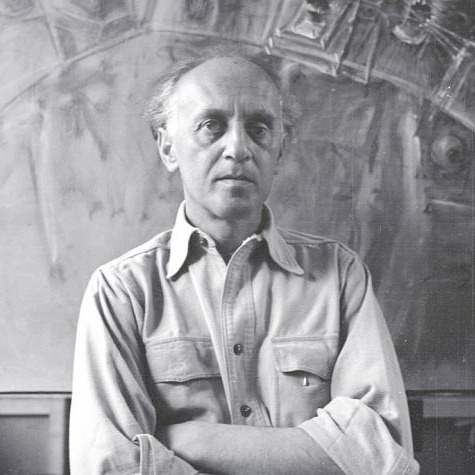
Victor Brauner
Victor Brauner, a leading member of the Romanian avant-garde, was renowned for his explorations of spiritualism, myth, and prediction. While initially exploring various approaches such as Dada and Expressionism, Brauner was affiliated with the Surrealists.
Biography of Victor Brauner
Born in 1903 in Piatra Neamț, in the Romanian region of Moldavia, Victor Brauner was the third of six children in a Jewish family with a timber merchant father. The family often moved, residing in Hamburg (Germany) in 1907 and Vienna in 1912. Upon returning to Romania in 1914, he pursued schooling at the Lutheran school in Brăila, concentrating on zoology.
Brauner's enduring interest in spiritualism and magic, influenced by his formative years, shaped his artistic career. The Hasidic Judaism surrounding him in Moldavia fostered an affinity for the Kabbalah, evident in many of his artworks.
Attending the National School of Fine Arts in Bucharest from 1916 to 1918, Victor Brauner furthered his studies at the Horia Igiroşanu private school of painting and the Beaux-Arts school in Bucharest, where he explored landscape painting in the style of Paul Cézanne.
Expelled from the latter for "misbehavior and anti-conformist painting," Brauner embarked on travels across Romania, including visits to Fălticeni and Balchik, where he delved into experimentation with Dadaism, Abstractionism, and Expressionism.
In 1924, he showcased his inaugural solo exhibition, featuring Expressionist-style paintings. Concurrently, he co-founded the Dadaist-Constructivist review "75 HP" with poet Ilarie Voronca. Embracing picto-poetry, a fusion of writing and images, Brauner proclaimed its significance in revitalizing artistic currents.
In 1925, Victor Brauner's inaugural visit to Paris placed him on Moulin Vert Street, residing in the same building as Swiss sculptor Alberto Giacometti and French Surrealist painter Yves Tanguy. Tanguy introduced Brauner to the Surrealists. During his time in Paris, Brauner forged connections with notable figures, including Romanian sculptor Constantin Brancusi, who imparted the techniques of art photography. He also befriended poets Gellu Naum and Benjamin Fondane, along with artists such as Robert and Sonia Delaunay, Marc Chagall, Jacques Hérold, Marcel Duchamp, and Man Ray.
In 1930, Brauner established a more permanent residence in Paris and married Margit Kosch, a union that ended nine years later.
Notably, in 1931, he created one of his iconic works, "Self-Portrait with Plucked Eye," eerily foretelling the loss of his left eye on August 28, 1938. The incident occurred during a violent dispute between Spanish Surrealist painters Oscar Domínguez and Esteban Francés, where Brauner, attempting to shield Francés, was struck by a thrown glass from Domínguez.
In 1934, Victor Brauner held his first solo Paris exhibition at the Galerie Pierre, featuring an enthusiastic catalogue introduction by André Breton praising Brauner's "violently unleashed imagination." Despite Breton's acclaim, the show received a tepid reception, leading to Brauner's disheartenment and financial constraints.
In 1935, he returned to Bucharest, half-heartedly engaging with the Romanian Communist Party. During this period, the artist stopped painting, but he produced caricatures and illustrations, including the "Anatomy of Desire" series (1935-36). Brauner relocated back to Paris in 1938, where he met Jacqueline Abraham, who later became his second wife in 1946.
As World War II erupted, Brauner, marked by his Romanian identity, Jewish heritage, past Communist involvement, and association with "Degenerate Art," found himself compelled to hide. Fleeing to Southern France, he resided in Perpignan, Cant-Blame, the Eastern Pyrenees, and eventually Saint Feliu d'Amont. Despite these challenges, he maintained contact with fellow Surrealists in Marseille and officially settled there in 1941, granted permission. Around the same period, Brauner unsuccessfully attempted to secure a visa for travel to the United States.
During the winter of 1940-1941 at Villa Air-Bel, the Surrealists engaged in collaborative endeavors and crafted collective works, including a version of the game "exquisite corpses" and a Tarot deck rejecting military and religious references. In this Tarot project, contributors chose two personalities for their cards, and Victor Brauner selected philosopher Hegel and renowned medium Helen Smith, portraying them as hybrid human-animal forms. Brauner found joy in such playful collaborations with the Surrealists.
As World War II neared its end, Brauner, seeking refuge from increasing Nazi persecution, moved to Switzerland. His frequent relocations prompted a shift to smaller canvas dimensions, allowing easy transport, referred to as 'suitcase paintings.'
In 1945, Victor Brauner returned to Paris, featuring in the International Exhibition of Surrealism at Galerie Maeght in 1947. However, in 1948, he was expelled from the Surrealists by Breton for refusing to support the unclear expulsion of prominent member Roberto Matta. From this point onwards, Brauner shifted away from traditional Surrealism, delving into drawing on paper, encaustic painting, and thin oil paint on boards, producing flatter, more stylized, and abstracted pieces.
In 1959, Brauner occupied a studio at 72 Rue Lepic in Montmartre. Settling in Varengeville, Normandy, in 1961 after a trip to Italy, he garnered attention with a solo exhibition at New York City's Bodley Gallery the same year. In 1966, he represented France at the Venice Biennale, earning an entire hall dedicated to his work. Following a prolonged illness, Brauner passed away in Paris in 1966. His final resting place is at the Montmartre cemetery, with his tomb inscribed with a line from his notebooks: "Peindre, c'est la vie, la vraie vie, ma vie" ("Painting is life, the real life, my life").
Victor Brauner significantly influenced Surrealist art by expanding its vocabulary and drawing inspiration from diverse sources such as alchemy, mythology, Judaism, Hinduism, Aztec, and Native American belief systems. His contributions broadened the scope of the Surrealist movement, providing contemporaries with new tools for expression.
In contrast to his peers, Brauner's art stood out due to the development of a private and deeply personal iconography rooted in his own existence.
Years:
Born in 1903
Country:
Romania, Piatra Neamț
Gallery: